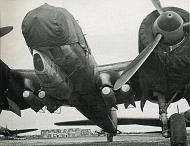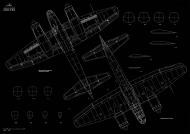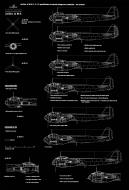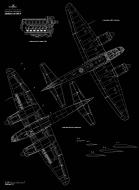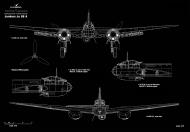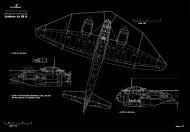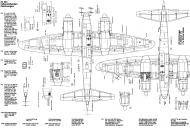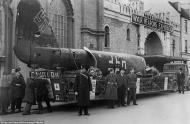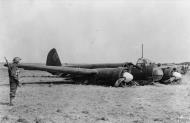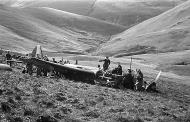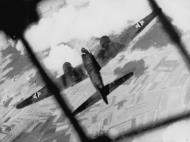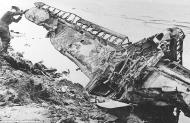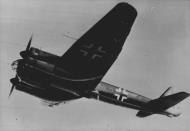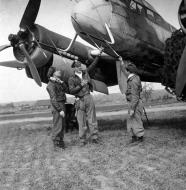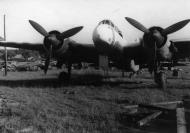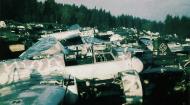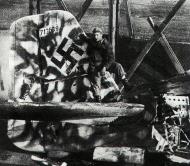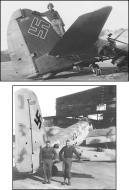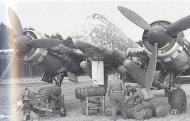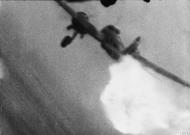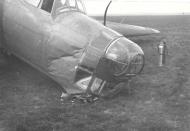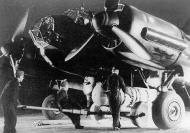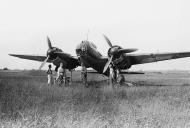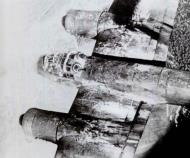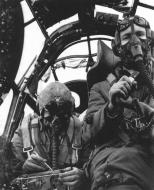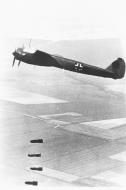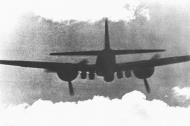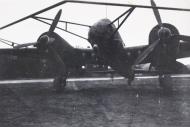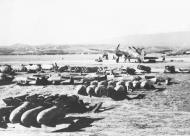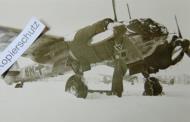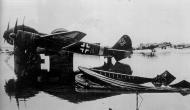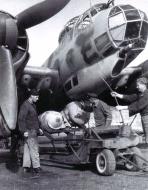Junkers Flugzeug-und Motorenwerke AG (JFM)
Junkers Ju 88
German aircraft manufacturer: Junkers Flugzeug-und Motorenwerke AG (JFM), more commonly Junkers
Certainly the most versatile German warplane of World War II, the Junkers Ju 88 in progressively improved versions continued in production throughout the war. It was originated to meet a requirement for a three-seat high-speed bomber and the first prototype, powered by two 746kW Daimler-Benz DB 600Aa engines, made its initial flight on 21 December 1936. Further prototypes followed, the third with 746kW Junkers Jumo engines and this, during evaluation, attained a speed of 520km/h. Such high performance encouraged record-breaking attempts, and in March 1939 the fifth prototype set a 1,000km closed-circuit record of 517km/h carrying a 2000kg payload. A total of 10 prototypes was completed, and the first of the pre-production Ju 88A-0 bombers flew in early 1939, the initial Ju 88A-1 production version entering service in September 1939.
Early operational deployment showed that despite good performance and a worthwhile bombload, defensive armament was totally inadequate, leading to the Ju 88A-4 with increased span wings, structural strengthening to carry greater loads and gunpower increased substantially. This formed the basis for further diverse development of the type, ultimately in so many versions that a detailed listing of them is not possible: for example, the Ju 88A series extended over Ju 88A-1 to Ju 88A-17 sub-variants. While the Ju 88A was in production an improved Ju 88B was planned, with a more extensively glazed nose and power provided by two 1193kW B.M.W. 801MA radials, but flight testing showed only marginal performance improvement and only 10 pre-production Ju 88B-0 aircraft were built.
The Ju 88 was almost as fast as contemporary fighters, and such performance coupled with excellent manoeuvrability brought development of the Ju 88C series. The planned Ju 88C-1 with B.M.W. 801 MA engines was abandoned because the new Focke-Wulf Fw-190 fighter had priority for this powerplant. As a result the first production version was the Ju 88C-2, this being the Ju 88A-1 converted on the production line to have a solid nose mounting three 7.92mm MG 17 machine-guns and a 20mm MG FF cannon. Defensive armament comprised two additional 7.92mm MG 15 machine-guns. The Ju 88C-4 was a heavy fighter/reconnaissance model, the Ju 88C-5 an improved heavy fighter, the Ju 88C-6a an improved Ju 88C-5, the Ju 88C-6b and Ju 88C-6c night-fighters, the Ju 88C-7a and Ju 88-C7b intruders, and the Ju 88C-7c, a heavy fighter. Alphabetically out of sequence were the Ju 88R-1 and Ju 88R-2 night-fighters, which were developed and powered by B.M.W. 801 MA engines when the supply position of this powerplant eased.
The Ju 88D series was long-range reconnaissance aircraft based on the Ju 88A-4, in Ju 88D-1 to Ju 88D-5 variants that differed in engines, and detail. The Ju 88G series represented definitive night-fighter versions that from the early summer of 1944 replaced the earlier Ju 88C and Ju 88R aircraft. Equipped with airborne interception radar and bristling with weapons, the Ju 88Gs were extremely formidable night-fighters, taking a heavy toll of Allied night bombers. They were followed by small numbers of Ju 88H aircraft which had a lengthened fuselage to provide increased internal fuel capacity, providing extra long-range Ju 88H-1 reconnaissance and Ju 88H-2 fighter aircraft. The tank-busting Ju 88P was developed from the Ju 88A-4, the Ju 88P-1 with a 75-mm PaK 40 cannon and the ensuing Ju 88P-2 to Ju 88P-4 with different combinations of heavy anti-tank weapons.
The increasing capability of Allied fighters meant that losses began to rise, leading to the higher-performance Ju 88S bomber and Ju 88T photo-reconnaissance aircraft that represented the final production versions. When production ended almost 15,000 had been built, this total emphasising the significant role that the Ju 88 had played in Luftwaffe operations.
By the middle of 1944, the night fighter force had become the strongest and most efficient arm of the Luftwaffe, comprising almost fifteen per cent of its first line strength. From May 1940 onwards, the appearance of ever increasing numbers of RAF bombers at night over Germany had forced the Luftwaffe to set up a powerful night air defence organisation which soon became involved in a bitter see-saw battle for supremacy in the night sky. The Junkers Ju 88 night-fighter was a key weapon in this crucial battle. From 1944 until the end of the war, Ju 88s equipped the vast majority of Nachtjagd units, and constant development of the airframe and of numerous electronic aids maintained its reputation as a formidable fighting machine until the very end.
The Junkers Ju 88 first arose from a German Air Ministry requirement for a dedicated high-speed medium bomber. In a calculated move, Junkers temporarily recruited two engineers from America to help design the new aircraft. W.H. Evers and Alfred Grossner applied their considerable expertise in modern aircraft structural design to produce in the Ju 88 a remarkably efficient and adaptable design. The first prototype (D-AQEN) flew on 21 December 1936, and subsequent testing of additional prototypes confirmed its excellent performance. A production order followed and Luftwaffe service testing commenced early in 1939.
The performance of the prototype had generated early interest in adapting the type for other roles, and one of the first roles considered was that of Zerstörer (heavy-fighter). The Luftwaffe concept of a twin-engined high-speed long-range day fighter was widely shared by other European air forces at the time. Accordingly, in early summer 1939, Junkers modified the Ju 88 V7 prototype to include a forward-firing armament of two 20 mm MG FF cannon and two 7.9 mm MG 17 machine-guns located in a modified nose section partially covered by metal plates. The underfuselage gondola was also removed and the crew reduced to three. Powered by two 1,200 hp Junkers Jumo 211B-1 engines, the unmodified Ju 88 V7 had first flown on 27 September 1938, and was soon back in the air testing the new armament. The new fighter offered a maximum speed similar to that of the much smaller Messerschmitt Bf 110, but with three times the range, and the type was ordered into limited production.
A small batch of early production Ju 88A-1 bombers were converted into Ju 88C-0s during July and August 1939, and used operationally during the invasion of Poland by the Zerstörerstaffel of KG 30 for long-range ground-attack. It was initially planned that the subsequent production variants would be the the Ju 88C-1 with 1,600 hp BMW 801MA air-cooled radials, and the Ju 88C-2 with liquid-cooled 1,200 hp Jumo 211B-1 engines behind annular radiators. In the event, the BMW 801 engines were reserved for the new Focke-Wulf Fw-190 fighter and the C-1 and the proposed C-3 derivative were abandoned. The first production model was thus the C-2 with an armament of one 20 mm MG FF cannon and three 7.9 mm MG 17 machine-guns in a new smooth metal nose section. These aircraft were converted on the production line, and retained the ventral gondola. The C-2s were used for more than a year for coastal and anti-shipping patrol, before another role appeared.
From May 1940, the RAF began to attack Germany regularly by night and it was quickly realised that anti-aircraft guns alone would not be able to defend Germany adequately. Accordingly, the Zerstörerstaffel of KG 30 was reinforced with additional Ju 88C-2s and redesignated II/NJG 1 in July, joining the newly established night-fighter force under General Kammhuber. The Gruppe specialised in conducting night intruder operations - hunting RAF bombers over British aerodromes identified by radio intercepts. On 11 September 1940, the Gruppe was redesignated I/NJG 2. The small number of intruder aircraft available was hopelessly inadequate to counter the ever increasing threat from Bomber Command, and the perceived lack of results led to Hitler ordering the end of further intruder operations on 12 October 1941. I/NJG 2 was soon transferred to Sicily for intruder operations over Malta and the Mediterranean.
In the mean time, a new Zerstörer variant had been developed, the Ju 88C-4. This was similar to the C-2, but used the improved airframe of the Ju 88A-4, featuring increased overall wing span from 60 ft 3¼ in (18.37 m) to 65 ft 7½ in (20.0 m) and a sturdier undercarriage. Other improvements included more armour protection for the crew and an extra 7.9 mm MG 15 machine-gun in the rear of the offset ventral gondola. The Junkers Jumo 211B-2 powered C-4 was the first C-series model produced as new-build and not by conversion. Production numbers of the C-4 remained relatively low compared to the bomber variants. A modified version, the Ju 88C-6 was operated by V/KG40 from September 1942 to counter RAF Coastal Command operations against U-boats in the Bay of Biscay. Later the Gruppe was absorbed into ZG 1 but disbanded in June 1944. Other C-6s were used for train-busting on the Russian Front in 1943.
Early in 1942, the new FuG 212 Lichtenstein C-1 radar was experimentally fitted to four of NJG 1s Ju 88C night-fighters. The cumbersome 'stags antlers' aerial array reduced maximum speed by 15-25 mph and so the reaction of crews was initially unfavourable, until a number of kills were scored using it. The introduction of radar on the Ju 88C-6 resulted in a designation change to Ju 88C-6b, while existing day-fighter aircraft were retrospectively redesignated Ju 88C-6a. The initial radar fit was the FuG 202 Lichtenstein BC, but by the Autumn of 1942 this had been replaced by the simplified FuG 212 Lichtenstein C-1. In a parallel development, the Ju 88R-series of night fighters differed from the Ju 88C-6b mainly in having BMW 801 engines.
The 'Himmelbett' defensive system of ground controllers directing night-fighters to within visual range of a their targets was now well established, and the introduction of radar made the last phase of an intercept much easier. Previously quite scarce in the Nachtjagd (most Ju 88Cs were still in the Mediterranean), the Ju 88 now began to equip an increasing number of night-fighter units. Night-fighters were meant to keep to their assigned control sector, but when it was found that a narrow bomber stream would saturate the relatively thin 'Kammhuber line' of defensive sectors, a more free-ranging 'Zahme Sau' technique - whereby some night-fighters would join and follow bomber stream - was introduced. The long-range Ju 88C-6b and Ju 88R-1 were particularly suited to this role, and began to equip many units. A major set-back for the night-fighters was the use of 'Window' jamming by the RAF, first introduced on 24/25 July 1943. This rendered existing ground and airborne radars useless, and it wasn't until October 1943 that the Ju 88C-6c appeared with a FuG 220 Lichtenstein SN-2 radar which operated on a different frequency. In the meantime, 'Zahme Sau' tactics dominated, with night-fighters using FuG 227 Flensburg which homed-in on Allied bomber 'Monica' tail-warning radars. By April 1944, the Ju 88C-6c equipped almost the entire Nachtjagd.
In the Summer of 1942, the war on the Russian Front had meanwhile highlighted a need for dedicated ground-attack/tank-buster aircraft. Among the possible solutions was a Ju 88C-4 experimentally fitted with a Nebelwerfer recoilless rocket launcher. This weapon reassembled a six-barrelled gatling gun and the modified aircraft was unofficially known as the Ju 88N or Ju 88Nbwe. Trials of this weapon were soon abandoned in favour of the Ju 88P series. The Ju 88P V1 was a modified Ju 88A-4, with a large belly fairing housing a 75 mm KwK 39 cannon firing forward and two MG 81Z machine-guns at the rear. Trials were relatively successful and a small number of Ju 88P-1 production aircraft were ordered. The Ju 88P-1 featured a Ju 88C solid nose, armour protection for the engines and a 75 mm PaK 40L cannon with a big muzzle brake. The type was issued to a few units in 1943 for operational testing, but proved very unwieldy and vulnerable to enemy fighters. Effectiveness was reduced by the gun's slow rate of fire. Two further versions, the Ju 88P-2 with two 37 mm BK 3.7 Fak 18 canon and the Ju 88P-3 with increased armour protection were only completed in small numbers. The final tank-buster variant was the Ju 88P-4 with a single 50 mm Bk 5 cannon in a much smaller belly fairing. All four variants saw active service on the Eastern Front in 1944. Some were used as train-busters, while a small number of P-2s were tried as night-fighters and day interceptors against USAAF bomber formations - proving to be completely unsuitable.
The introduction of increasingly heavier armament, more armour, and a radar operator had a detrimental affect on the low-speed handling qualities of the overburdened Ju 88C series, and it was becoming apparent that the development of a specialised Ju 88 night-fighter model was now necessary to restore lost performance and safe handling. In 1943, a Ju 88R-2 was experimentally fitted with the enlarged squared-off tail unit of the Ju 188, becoming the Ju 88 V58. A completely revised armament fit was introduced. Two MG 151/20 cannon were housed in the right-hand side of the nose, and four more located in a ventral tray under the left side of the belly. Designated Ju 88G V1, the new version first flew in June 1943 and served as the prototype for a new series of night-fighters. The Ju 88G-0 pre-production aircraft differed from the prototype in deleting the nose mounted MG 151 cannon, as they blinded the pilot at night. The increased power of the 1,700 hp BMW 801D radials helped restore much of the type's good handling qualities. The Ju 88G-1 was the first series production version, essentially the same as the G-0. The new model rapidly replaced the Ju 88C from the middle of 1944, many with FuG 227 Flensburg which homed in on British 'Monica' tail warning radar. The next production version was the Ju 88G-6a, similar to the G-1 but with two 1,700 hp BMW 801G engines. The Ju 88G-6b carried the FuG 350 Naxos Z radio equipment which homed-in on bomber H2S blind-bombing radar emissions, larger fuel tanks and two MG 151/20 cannon in a 'Schräge Musik' installation firing obliquely upwards and forwards from the upper fuselage - usually at an angle of 70 degrees. The pilot simply formated under the bomber and fired upwards in an easy zero-deflection shot.
The final production G series model was the Ju 88G-7, powered by two Jumo 213E engines with MW-50 power boosting to 1,800 hp on take-off. The Ju 88G-7a had FuG 220 Lichtenstein SN-2 radar, while the Ju 88G-7b had FuG 218 Neptune V radar with either the standard 'toasting fork' aerials or a Morgenstern array enclosed in a pointed wooden nose cone. The G-7c had FuG 240 Berlin N-1 centimetric radar with the scanner enclosed in a plywood nose cone. Only ten G-7c were completed, before the end of the war.
In the last few months of the war, a number of G-1 airframes were converted to act as the warhead portion of the Mistel flying bomb. Pilotless missile steered by the fighter mounted on top. A Focke-Wulf Fw-190 was mounted above the Ju 88 to guide it towards the target, before releasing at the last moment. Some isolated successes were scored in attacking bridges.
Immediately after the end of the war, Allied intelligence teams rapidly moved into Germany to secure examples of all the latest aircraft. A significant number of Ju 88G series aircraft were brought back to France, Britain and the USA for thorough evaluation. All of these machines were later scrapped. It does not appear that any example of the Ju 88G reached the Soviet union.
Derived from undoubtedly the most versatile German combat aircraft of WW2, the Ju 88 night-fighter was a refined and formidable aircraft, with a powerful armament, excellent agility and advanced electronic sensors. It is therefore appropriate that Ju 88 night-fighters destroyed more Allied night bombers in WW2 than all other fighters combined.
History
The Junkers Ju 88 represented one of the better and more successful bomber designs attributed to the German Luftwaffe. The system performed on a variety of levels, achieving success with most every role and saw production reach totals well past 15,000 examples. Though operating for a nation whose bomber squadrons are rarely the cause for general discussion of the air war in World WAr-2, the Junkers Ju 88 stands out as a formidable and successful flyer that provided German warplanners with a versatile performers and equally terrified the leaders of opposing countries.
At its core, the Ju 88 was simple twin-engine monoplane system built around a thin pencil-like fuselage with a single vertical tail surface. The crew compartment was fitted to the extreme forward portion of the fuselage and held accommodations for up to four personnel under glazed glasswork. The Ju 88 had provisions for an internal and (later models) external bomb loadouts along with a defensive array of machine guns of various types.
The initial Ju 88V-1 prototype first as early as 1936, though it accommodated just three personnel and was fitted with Daimler-Benz DB 600A series engines of 1,000 horsepower each. Production models entered service by the end 1939 as the Ju 88A-1 and in time for the full-swing of the Second World War. Most notably, the Ju 88 series took part in the 1940 summer offensive against England in the famed 'Battle of Britain', serving the gamut of roles in varying forms - some featuring rocket-assisted take-off for quick action response.
The Ju 88 proved to be a versatile component to the Luftwaffe arsenal. It represented the fastest of the German bombers available and much was made with its advantage in speed. The system would go on to be fielded on every front that Germany was fighting on and was also well-noted for its anti-shipping capability against the Allied convoys thanks to several conversion models fitted with specialized radar and anti-ship munitions. As prized as the platform was, its final claim to fame would be recognized in the use of the Ju 88's bomb-laden fuselage as part of the Mistel - a fighter aircraft/Ju-88 combination where the piloted fighter (various were considered including the Fw-190, Me-262 and Me 109 platforms) would be mounted atop a crewless, yet bomb-laden Ju 88 fuselage, component which would later be jettisoned onto a target. Another in the seemingly long line of ingenious - yet desperate and ill-fated - concoctions related to the Luftwaffe and the closing months of World WAr-2 but such was the end for this fine machine.
Specifications (Junkers Ju 88A-4)BASE INFORMATION:
Base Series Designation: Junkers Ju 88
Classification Type: Medium Bomber / Dive Bomber
Contractor: Junkers - Germany - View All
Country of Origin: Nazi Germany
Initial Year of Service: 1939
Crew / Passengers: 4
Production Total: 15,000* - View Totals Page
*Sometimes an estimate when actual production numbers are not available.
*A value of 0 indicative of NA.DIMENSIONS:
Length: 47.24 ft | 14.40 m
Wingspan/Width: 65.62 ft | 20.00 m
Height: 15.91 ft | 4.85 m
Empty Weight: 21,738 lbs | 9,860 kg
MTOW: 30,865 lbs | 14,000 kgPERFORMANCE:
Engine(s): 2 x Junkers Jumo 211J-1 OR 211J-2 series V12 engines generating 1,340hp. - Compare Stats
Max Speed: 280 mph | 450 km/h | 243 kts
Max Range: 1,696 miles | 2,730 km
Service Ceiling: 26,903 ft | 8,200 m | 5.1 miles
Climb Rate: 770 ft/min (234 m/min)ARMAMENT:
External Hardpoints: 2
Armament:
7 x 7.92mm MG15 OR MG81 type machine guns in nose, dorsal and ventral gun positions.Up to 7,935lbs of externally and internally carried stores.
Major Series Variants & Known Global OperatorsDevelopment History:
Ju 88C V1: Prototype Zerstörer. Conversion of Ju 88 V7. Four crew, two 1,200 hp (895 kW) Jumo 211B-1 liquid-cooled engines, three MG 15s plus internal bomb load.
Ju 88C-0: Pre-production version of Zerstörer. Conversions of Ju 88A-1 aircraft.
Ju 88C-1: Planned production version of C-0 with two 1,600 hp BMW 801MA air-cooled radial engines. Conversion of A-1 with three MG 17 machine-guns and one 20 mm MG FF cannon. None completed.
Ju 88C-2: Initial production version for Zerstörer role. Modified Ju 88A-1 with new non-glazed nose, two 1,200 hp Jumo 211B-1 engines, 3 crew, three fixed forward-firing 7.9 mm MG 17 machine-guns and one 20 mm MG FF cannon, plus two defensive 7.9 mm MG 15 machine-guns in dorsal and ventral positions. Maximum bomb load 1,102 lb (550 kg).
Ju 88C-3: Modified C-2 with two 1,600 hp BMW 801MA engines. One conversion.
Ju 88C-4: Zerstörer/reconnaissance version. Modified Ju 88A-4 with solid nose, two Jumo 211F-1 engines, increased armament to two 20 mm MG FF cannon in ventral gondola (swapped for cameras in recce role), extra 7.9 mm MG 15 in rear of gondola, more crew armour protection, increased weight, strengthened undercarriage. First new-build version.
Ju 88C-4/R: Late production model of C-4 with 1,340 hp (1,000 kW) Jumo 211J-1 or J-2 engines.
Ju 88C-5: Zerstörer version. Improved C-4 with two 1,700 hp (1268 kW) BMW 801D-2, 3 crew, ventral gondola replaced by 'Waffentropfen' weapon pack below fuselage with two MG 17s and MG FF cannon replaced by MG 151. 10 pre-production examples only.
Ju 88C-6a: Day-Zerstörer version. Modified C-4 with two Jumo 211J-1 or J-2 engines, increased armour plating, fixed armament of three 7.9 mm MG 17s and one 20 mm MG FF cannon in the nose plus two MG FF in re-introduced ventral gondola plus one defensive MG 15 or MG 131. Various armament modifications.
Ju 88C-6b: Night-fighter version. Designation applied retroactively to C-6a when fitted with FuG 202 Lichtenstein BC or (by Autumn 1942) FuG 212 Lichtenstein C-1 radar. New HF radio.
Ju 88C-6c: As C-6b with FuG 220 Lichtenstein SN-2 plus (some models) Lichtenstein C-1, defensive armament one MG 131, some later with two oblique upward-firing 20 mm MG 151s in dorsal 'Schräge Musik' installation. Some with Jumo 211H turbocharged engines.
Ju 88C-7a: Intruder version with two Jumo 211J-1 engines, 2-3 crew, ventral gondola replaced by jettisonable ventral weapon pack with two MG FF/M, three fixed forward-firing MG 17s, max bomb load 1,102 lb (500 kg).
Ju 88C-7b: As C-7a with underwing bomb-racks, max bomb load 3,305 lb (1,500 kg).
Ju 88C-7c: Zerstörer version, modified C-7a, two 1,600 hp BMW 801MA engines, three MG 17 and one MG 151 in nose plus two MG FF in weapon pack, no bomb racks. Pre-production batch only.
Ju 88P V1: Anti-tank prototype. Modified A-4 with one 75 mm KwK 39 anti-tank cannon forward plus twin 7.9 mm MG 81Z aft of large ventral fairing. Two 1,340 hp Jumo 211J engines.
Ju 88P-1: Production model of Ju 88P V1 with solid unglazed nose, KwK 39 replaced by 75 mm PaK 40 anti-tank cannon, 2 or 3 crew, one forward firing MG 81 for sighting of cannon plus two twin MG 81Zs.
Ju 88P-2: As P-1 with two 37 mm BK 3.7 (Flak 38) cannon in large ventral fairing. A-4 conversions.
Ju 88P-3: As P-2 with increased armour plating, two Jumo 211H engines. A-4 conversions.
Ju 88P-4: Heavy fighter/anti-tank version, two Jumo 211J-2 engines, offensive armament reduced to single 50 mm BK 5 cannon, shortened ventral fairing. One aircraft fitted with 22-shot launcher for RZ 65 rockets, for testing.
Ju 88R-1: Night-fighter version. Re-engined C-6b with two 1,600 hp BMW 801MA or 801C engines and FuG 212 Lichenstein C-1 radar. Three MG 17 and one 20 mm MG 151/20 in nose plus two MG FF in ventral gondola.
Ju 88R-2: Version of R-1 with two 1,700 hp BMW 801D and the addition of FuG 202 Lichtenstein BC plus FuG 217 Neptun R tail-warning radar. Some also fitted with FuG 350 Naxos Z passive radar.
Ju 88G V1: Prototype of improved night-fighter version. Modified Ju 88R-2 with two 1,700 hp BMW 801D engines, 3 crew, two fixed MG 151s in fuselage nose and four fixed MG 151/20s in ventral gun tray plus one 13 mm MG 131 at rear of cockpit, FuG 212 Lichtenstein C-1 radar.
Ju 88G-0: Pre-production night-fighter version. Reduced armament (four MG 151/20), FuG 220 Lichtenstein SN-2 radar, more angular fin and rudder shape.
Ju 88G-1: Production version of G-0. BMW 801D engines. Some modified equipment, four MG 151s in ventral gun tray; Lichtenstein SN-2 radar plus FuG-227 Flensburg homing receiver.
Ju 88G-2: Version of G-1 with revised equipment. Production cancelled.
Ju 88G-3: Project only.
Ju 88G-4: Improved version of G-1. Small equipment changes. Some with two oblique upward-firing 20 mm MG 151 in dorsal 'Schräge Musik' installation.
Ju 88G-5: Version of G-1 with revised equipment. Project only.
Ju 88G-6a: Version of G-4. Dorsal 'Schräge Musik' installation now standard with two 20 mm MG 151/20s. Two 1,700 hp BMW 801G engines, improved equipment. Aft facing antenna for SN-2 introduced.
Ju 88G-6b: As for G-6a , addition of FuG 350 Naxos Z in cockpit roof, increased fuel capacity.
Ju 88G-6c: Two 1,750 hp (1,306 kW) Jumo 213A, reduced fuel capacity, 'Schräge Musik' installation moved to just aft of cockpit.
Ju 88G-7a: Introduced pointed wing tips from Ju 188, span increased to 72 ft 2 in?, two 1,725 hp Jumo 213E with MW 50 power booster, very broad propeller blades, 3 crew, FuG 220 Lichtenstein SN-2 radar.
Ju 88G-7b: As G-7a with FuG 228 Lichtenstein SN-3 or FuG 218 Neptun VR radar (as Ju 88G-7n), some with pointed wooden nose cone.
Ju 88G-7c: As for G-7a with FuG 240 Berlin N-1a radar in blunt wooden nose cone. No external aerials.
Ju 88G-8: Long range Zerstörer. As for G-7 but with fuselage of H-2.
Ju 88G-10: Similar to G-8 but used for Mistel programme.
Ju 88G-12: Developed into the Ju 188R series.
Ju 88H-2: Long range fighter version of Ju 88H-1 reconnaissance aircraft. Based on stretched Ju 88D-1 fuselage with Ju 88G-1 wings and engines. Two 20 mm MG 151 cannon in solid nose and four more in belly pack. No radar.
Ju 88N: Unofficial designation for one Ju 88C-4 fitted with Nebelwerfer rocket launcher.
Mistel 2: Composite flying bomb with Fw-190A-6 (or Fw-190F-8) upper stage and Ju 88G-1 lower stage. Cockpit section replaced by bolt-on shaped charge warhead.
Mistel S2: Trainer conversion of Mistel 2.
Mistel 3C: Composite flying bomb with Fw-190A-8 and Ju 88G-10. Project only.
Key Dates: (All Ju 88 references are very vague on precise dates) 15 January 1936 Start of Ju 88 project design 21 December 1936 Ju 88 V1 first flight 27 September 1938 Ju 88 V7 first flight (to Ju 88A-0 standard) summer 1939 Ju 88 V7 converted to Zerstorer configuration as Ju 88C prototype July 1939 Ju 88C-0 first flight July-August 1939 First batch of Ju 88C-0s converted September 1939 First operational use of Ju 88C-0 (by Zst./KG30) late 1940 First delivery of Ju 88C-2 production version to Luftwaffe (to Zst./KG30) 17 July 1940 Luftwaffe Nightfighter force established July 1940 First delivery of Ju 88C-2 variant July 1940 Zst./KG30 becomes II/NJG 1 11 September 1940 II/NJG 1 redesignated I/NJG 2 December 1940 First delivery of Ju 88C-4 variant 12 October 1941 Night intruder operations over Britain prohibited December 1941 I/NJG 2 transferred to Sicily early 1942 First test radar fitted to a Ju 88C April 1942 I/NJG 2 transferred to North Africa mid 1942 Ju 88C-6a first flight Summer 1942 Ju 88P V1 conversion of Ju 88A-4 late 1942 First production version with radar: Ju 88C-6b early 1943 Ju 88R-1 deliveries start June 1943 Ju 88 V58 converted from Ju 88R-2 as Ju 88G prototype October 1943 Ju 88C-6c introduced with FuG 220 radar not susceptible to original 'Window' jamming Spring 1944 First production Ju 88G-1 first flight May 1944 Ju 88G-1 enters service mid 1944 Ju 88G-6a first flight 3 March 1945 Mass night intruder operation over Britain
MAJOR SERIES VARIANTS:
Ju 88V-1 - Prototype Model; three seat crew compartment; fitted with Daimler-Benz DB600A V-12 1,000hp engines; total of ten prototype produced.
Ju 88A-0 - Pre-Production Model Designation
Ju 88A-1 - Initial Production Models; Series A Subvariant.
Ju 88A-2 - Series A Subvariant; fitted with rocket-assisted take-off.
Ju 88A-3 - Series A Subvariant
Ju 88A-4 - Series A Subvariant; Fitted with Junkers Jumo 211J-1 or Junkers Jumo 211J-2 class engines; increased wingspan; reworked and strengthened landing gear.
Ju 88A-5 - Series A Subvariant; similar to the Ju 88A-4 model series.
Ju 88A-6 - Series A Subvariant; fitted with a balloon cable fender.
Ju 88A-6/U - Long-Range Maritime Bomber; fitted with FuG 200 search radar and applicable equipment.
Ju 88A-7 - Series A Subvariant
Ju 88A-8 - Series A Subvariant
Ju 88A-9 - Series A Subvariant; tropicalized version of the Ju 88A-1 model series.
Ju 88A-10 - Series A Subvariant; tropicalized version of the Ju 88A-5 model series.
Ju 88A-11 - Series A Subvariant; tropicalized version of the Ju 88A-4 model series.
Ju 88A-12 - Series A Subvariant
Ju 88A-13 - Series A Subvariant
Ju 88A-14 - Series A Subvariant; anti-ship strike platform.
Ju 88A-15 - Series A Subvariant; increased bombload capacity through an added buldge in fuselage bomb bay area.
Ju 88A-16 - Series A Subvariant
Ju 88A-17 - Series A Subvariant; anti-shipping torpedo bomber.
Ju 88S - Secondary Production Model; produced in three subvariants; fitted with BMW 801G 1,700hp engines; redesigned nose assembly; reduced bomb load reflected in improved performance.
Ju 88T - Reconnaissance Model
Ju 88H - Long-range Derivative
Ju 88C - Heavy Fighter Version developed from the Ju 88A model series; fitted with BMW 801A radial engines; solid designed nose for improved offensive armament; spawned nightfighter variants.
Ju 88G - Definitive Nightfighter Service Model
Ju 88R - Improved Ju 88C Model
Ju 88D - Long-range Reconnaissance Model
Ju 88P - Anti-Tank Model
Ju 188 - 'High Performance' Model
Ju 388 - 'High Altitude' ModelSpecifications
Junkers Ju 88C-6c
Role: Night-fighter
Crew: Three
Dimensions: Length 47 ft 1.25 in (14.36 m); Height 16 ft 7.5 in (5.06 m); Wing Span 65 ft 7.5 in (20.0 m); Wing Area 586.63sq ft (54.5 sq m)
Engine(s): Two liquid cooled, 12 cylinder inverted-Vee, Junkers Jumo 211J-1 (or J-2) of 1,340 hp (? kW) each.
Weights: Empty Equipped 19,973 lb (9,060 kg); Normal Take-off 27,227 lb (12,350 kg); Maximum Take-off ? lb (? kg)
Performance: Maximum level speed 303 mph (488 kph) at 19,685 ft (6,000 m); Cruising speed 263 mph (423 kph) at same altitude; Time to 19,685 ft (6,000 m) 12 min 42 sec; Service ceiling 32,480 ft (9,900 m); Normal range on internal fuel 1,230 mls (1,980 km).
Armament: Three fixed forward-firing 20mm MG FF/M cannon and three fixed forward-firing 7.9mm MG 17 machine guns in lower nose section, one flexible 13 mm MG 131 machine-gun at rear of cockpit. Optional 'Schräge Musik' installation in upper fuselage with two 20 mm MG 151 cannon firing obliquely forwardJunkers Ju 88G-1
Role: Night-fighter
Crew: Four
Dimensions:Length (excluding radar) 47 ft 8.5 in (14.54 m), (including SN-2 aerials) 54 ft 1.5 in (16.50 m); Height 15 ft 11 in (4.85 m); Wing Span 65 ft 7.5 in (20.0 m); Wing Area 586.63sq ft (54.5 sq m)
Engine(s): Two 14 cylinder, air cooled, BMW 801D-2 radials of 1,700 hp (1268 kW) each.
Weights: Empty Equipped 20,020 lb (9,081 kg); Normal Take-off 28,870 lb (13,095 kg); Maximum Take-off 32,385 lb (14,690 kg)
Performance: Maximum level speed 356 mph (573 kph) at 27,890 ft (8,500 m) with SN-2 but no upward-firing guns, 342 mph (550 kph) at same altitude with 'Schräge Musik' installation; Service ceiling 29,000 ft (8,840 m); Normal range 1,553 mls (2,500 km); Maximum endurance on internal fuel 4.75 hours.
Armament: Four fixed forward-firing 20mm MG 151 cannon in ventral tray with 200 rounds each and one flexible 13 mm MG 131 machine-gun at rear of cockpit with 500 rounds. Optional 'Schräge Musik' installation in upper fuselage with two 20 mm MG 151 cannon firing obliquely forwardJunkers Ju 88G-7b
Role: Night-fighter
Crew: Three
Dimensions:Length (excluding radar) 47 ft 8.5 in (14.54 m); Height 15 ft 11 in (4.85 m); Wing Span 65 ft 7.5 in (20.0 m); Wing Area 586.63sq ft (54.5 sq m)
Engine(s): Two liquid cooled, 12 cylinder inverted-Vee, Junkers Jumo 213E of 1,725 hp (? kW) each.
Weights: Empty Equipped 20,503 lb (9,300 kg); Normal Take-off 28,885 lb (13,100 kg); Maximum Take-off 32,353 lb (14,675 kg)
Performance: Maximum level speed 270 mph (434 kph) at sea level, 363 mph (585 kph) at 33,500 ft (10,200 m), 389 mph (626 kph) at 29,529 ft (9,000 m) with MW-50 emergency boost; Cruising speed 348 mph (560 kph) at 29,529 ft (9,000 m); Initial rate of climb 1640 ft/min (500 m/min); Time to 30,185 ft (9,200 m) 26 min 24 sec; Service ceiling 32,810 ft (10,000 m); Normal range 1,398 mls (2,250 km); Endurance (at maximum economical cruising speed) 3.72 hours at 29,800 ft (9,083 m).
Armament: Four fixed forward-firing 20mm MG 151 cannon in ventral tray with 200 rounds each, two fixed oblique upward-firing 20mm MG 151 cannon in dorsal 'Schräge Musik' position with 200 rounds each, one flexible 13 mm MG 131 machine-gun at rear of cockpit with 500 rounds.Production
Head of Design Team: Ernst Zindel (Structural design by W.H. Evers & Alfred Gassner)
Design Office: Junkers Flugzeug und Motorwerke AG, DessauJunkers Ju 88 Production Locations:
Arado at Brandenburg-Neuendorf (A-series bombers only, Nov 1939-Mar 1942 + wings only until Aug 1942)
ATG at Leipzig-Mockau (fuselages & tails, not wings + final assembly 1940-June 1944)
Dornier (North) at Wismar (A-series fuselages and tails, 1939-Jan 1942)
Dornier (South) at Friedrischshafen (A-series bombers only, 1939-Dec 1940)
Heinkel at Oranienburg (complete aircraft 1940-Aug 1942, wings only until March 1943)
Henschel at Berlin-Schönefeld (complete aircraft from mid 1939, night-fighters only 1944-Feb 1945)
Junkers at Bernburg (all variants 1938-1945)
(Fuselages from Aschersleben, wings from Halberstadt, tails from Leopoldshall with assembly at Bernburg)
Siebel at Halle (wings and final assembly, early 1940 - April 1944)
Also factories in Czechoslovakia and France by 1944
Major sub-assemblies produced by Volkswagen at Wolfsburg (tail units for Junkers until mid 1944) and AEG at ?? (tail units for Arado & others until mid 1944).
Junkers Ju 88 Production and development Version Quantity Assembly Location Time Period Ju 88C V1 1 a/c converted summer 1939 Ju 88C-0 few A-1 converted Jul-Aug 1939 Ju 88C-1 nil Ju 88C-2 62+ A-1 converted early Summer 1940-end 1940 Ju 88C-3 1 C-2 converted 1941 Ju 88C-4 <100 new build Sept 1941-spring 1942 Ju 88C-5 10 early 1942 Ju 88C-6a ) spring 1942 Ju 88C-6b 2,500+ late 1942 Ju 88C-6c ) Oct 1943-June 1944 Ju 88C-7a late 1943 Ju 88C-7b 1943 Ju 88C-7c 1943 Ju 88C series total c. 3,200* - - Ju 88P V1 1 conv A-4 Summer 1942 Ju 88P-1 ? conv A-4 1943 Ju 88P-2 ? conv A-4 Ju 88P-3 ? conv A-4 Ju 88P-4 32 conv A-4 1944 Ju 88P series total - - Ju 88R-1 early 1943-early 1944 Ju 88R-2 1943-1944 Ju 88R series total - - Ju 88G V1 1 R-2 converted spring 1943 Ju 88G-0 1944 Ju 88G-1 spring 1944 Ju 88G-4 1944 Ju 88G-6a 1944 Ju 88G-6b 1944 Ju 88G-6c 1944 Ju 88G-7a late 1944 Ju 88G-7b Feb 1945 Ju 88G-7c 10 spring 1945 Ju 88G-8 1945 Ju 88G-10 1945 Ju 88G series total c. 800 - - Ju 88H-2 10 Merseburg 1943 Mistel 2 125 Total: 3964 (fighters) * = includes R-series total. Total Produced: 15,018 a/c (All variants) More Info.
Junkers Ju 88
The Junkers Ju 88 was a World War II Luftwaffe twin-engine, multi-role aircraft. It was one of the most versatile combat aircraft of the war, with various roles including bomber, close-support aircraft, nightfighter, torpedo bomber, reconnaissance aircraft, heavy fighter, as well as a giant flying bomb in the Mistel project. There were 15,000 aircraft built during the Second World War.
At its core, the Ju 88 was simple twin-engine monoplane system built around a thin pencil-like fuselage with a single vertical tail surface. The crew compartment was fitted to the extreme forward portion of the fuselage and held accommodations for up to four personnel. The aircraft had provisions for an internal and later external bomb loadouts along with a defensive array of machine guns of various types.
Production models of the Ju 88 entered service by the end of 1939 and in time for World War II. It also took part in the 1940 summer offensive against England in the “Battle of Britain”, serving the gamut of roles in varying forms, with some aircraft featuring rocket-assisted takeoff for quick action response.
The Ju 88 proved to be a versatile component to the Luftwaffe arsenal. It represented the fastest of the German bombers available and much was made with its advantage in speed. The system would go on to be fielded on every front that Germany was fighting on and was also well-noted for its anti-shipping capability against the Allied convoys. Its final claim to fame would be recognized in the use of the Ju 88 as part of the Mistel: a fighter aircraft/Ju-88 combination where the piloted fighter would be mounted atop a crewless, bomb-laden Ju 88 fuselage, a component which would later be jettisoned onto a target.
Specifications
Length: 14.2 m (46 ft 6 in)
Wingspan: 18 m (59 ft 0 in)
Height: 4.7 m (15 ft 5 in)
Empty weight: 3,900 kg (8,600 lb)
Loaded weight: 7,700 kg (16,980 lb)
Powerplant: 2× Junkers Jumo 211A, Junkers Jumo 213, (or with BMW 801 radial engines in some cases) liquid-cooled inverted V-12, 900 kW (1,200 hp) each
Maximum speed: 510 km/h at 4,750 m (317 mph at 15,600 ft)
Range: 2,108 km (1,310 mi)
Armament: 3 to 6x 7.92 mm MG 15, MG 17, MG 81, or MG 81z machine guns; 1 to 3x 20 mm MG FF cannon depending on configuration; 2,500 kg (5,511 lb) of bombs maximum
Siegfried Holzbauer, a test pilot of Junkers, in 1941 made a proposal to use a combination of a fighter and a unmanned, bomb filled older bomber to throw the bomber on large targets like bridges, boats, factories, bunkers and so. At that time there was no need for such a radical method, so the idea was dropped. But when, at the end of the war, the Germans became desperate the idea was reborn (due to the successful flights with the DFS 230 combinations). The official name was 'Beethoven Gerät' or Beethoven Device. Most know it under the name 'Mistel' or Mistletoe.
As lower component they used a Junkers Ju 88. Messerschmidt Me 109s and Focke-Wulf Fw-190s were used as upper components. The Ju 88 got a special designed 380 pound warhead instead of the cockpit. At the second bomb bay 50 kg cement bombs were carried as ballast.The warhead could (at the used speed) penetrate 60 feet of reinforced concrete. Together that would give quite a bang.
DFS (having experience with the DFS 230 combinations) designed the support between the two components. The extra drag made the speed drop to 235 mph. This made the Mistel a easy target for enemy fighters.
Some operations were carried out. 4 attacked some boats, although all were direct hits, no ship sank. Several other operation were planned, but mostly dropped due to the continuously changing situation of territory. At the end most were used to destroy bridges to slow down the Allied and/or Russians.
There were about 250 Mistels made. At first older Ju 88 were used, at the end they used Ju 88s straight from the factory.
Due to the slowness of the Mistels using the Ju 88, they couldn't survive long in a hostile airspace. Arado suggested to use the Arado Ar-234, a multi jet-engine high-wing bomber or reconnaissance airplane, as a quicker base. A Mistel like proposal suggested a Ar-234/ Ar E377. The Arado Ar E377 was a unmanned mid-wing airplane which could have a 2000 kg (4409 lb) hollow-charge warhead or a 1800 kg (3968 lb) bomb mounted in the nose. Two version of this Ar E377 were suggested. A unpowered one and a version which had a jet-engine under each wing. Both combinations had the Ar E377 mounted on a takeoff trolley and the Ar-234 was mounted on top of the Ar E377. There was also a proposal to use a Heinkel 162 Volksjäger with the powered Ar E377. No prototypes were made. The war probably ended too soon.
Another interesting Arado project was to use the Arado 234 as a flying base for the Fieseler 103 (better known as the V-1). Three proposals for mounting the V-1 were made. One featured the use of a rigid tow bar behind the Ar-234. The second one mounted the V-1 on a takeoff trolley and the Ar-234 on top of it. The third had the V-1 mounted on top of the Ar-234. The last version made use of the conventional landing gear of the Ar-234. An unpowered V-1 was used during these tests. The fourth test ended in the destruction of the tow bar, due to the unstability of the concept.
The last parasite Arado proposal was the combination of a Ar-234 and a Ar E381. The Ar E381 was a small, rocket powered fighter. The reasoning was that the best way to protect a fighter was to place armor around the engine and the pilot. For conventional airplanes this would lead to a increase of weight that would reduce the performance a bit too much. The tiny Walter rocket engine could easily be protected using a small armored tube. Due to the ground clearance of the Ar-234 , the pilot of the Ar E381 (which was hung under the Ar-234) had to be proned. In this position a pilot could also easily be protected with a armored tube. The first design had one difficulty: once hung under the Ar-234; there was no possibility that the pilot could leave the Ar E381. A second proposal had a sideway entrance. The AR E381 had a single 30mm Mk 108 cannon and 45 rounds of ammunition. This would be good for two attacks.
References
'Squadron/Signal Junkers Ju88 in Action Part 2' by Brian Filley with Don Greer, Perry Manely and Joe Sewell
'German Air Force Bombers of World War Two - Vol. 2' by Alfred PriceSpecification
MODEL: Ju 88A-4
CREW: 4
ENGINE: 2 x Junkers Jumo 211J-1, 1007kW
WEIGHTS: Take-off weight: 14000 kg: 30865 lb: Empty weight: 9860 kg: 21738 lb
DIMENSIONS
Wingspan: 20.0 m: 65 ft 7 in:: Length: 14.40 m: 47 ft 3 in: Height
4.85 m
15 ft 11 in
Wing area: 54.50 m2: 586.63 sq ft
PERFORMANCE: Max. speed: 470 km/h: 292 mph
Ceiling: 8200 m: 26900 ft: Range w/max.fuel: 2730 km: 1696 miles
ARMAMENT: 5-7 machine-guns, 2000kg of bombs
Ju-88 Fighter Production by Year: Year Total Variants 1939 0* Ju 88C-0 1940 62** Ju 88C-2 1941 66 Ju 88C-4/5 1942 257 Ju 88C-6 1943 706 Ju 88C/R 1944 2518 Ju 88C/R/G 1945 355 Ju 88G-6/7 Total: 3964 * = includes R-series total. Total Produced: 15,018 a/c (All variants)
Luftwaffe Aircraft Squadron - Unit Codes Code Unit Aircraft A3+ Kampfgeschwacjer KG200 Ju-88A-4, D-6, S-3 A6+ Aufkiarungsgruppe 120 Ju-88D-1 B3+ Kampfgeschwader KG54 Ju-88A-4, A-14 B4+ Nachtjagdgeschwader NJG3 (Norwegia) Ju-88G-6 C6+ Aufkiarungsgruppe 121 Ju-88D-1 C9+ Nachtjagdgeschwader NJG5 Ju-88G-1,G-6 D5+ Nachtjagdgeschwader NJG3 Ju-88G-6 D7+ Wekusta 1 Ju-88A-4, D-1 D9+ Nachtjagdgruppe NJGr 10 Ju-88A-4, G-1.G-6 E6+ Aufkiarungsgruppe 122 Ju-88D-1 F1+ Kampfgeschwader KG76 Ju-88A-1, A-4, A-5 F2+ Erganzungs-Fernaufklarungsgruppe Ju-88D-1, T-1 F6+ Aufkiarungsgruppe 122 Ju-88A-5, D-1 F8+ Kampfgeschwader KG40 Ju-88C-6, R-2. G-1 G2+ Aufkiarungsgruppe 124 Ju-88D-1 G9+ Nachtjagdgeschwader NJG1 Ju-88A-4. C-6, R-1, G-1, G-6 H1+ Aufkiarungsgruppe 10 Ju-88D-1 K8+ Ju-88S-1,S-3 K9+ 3./ Aufkiarungsgruppe ObdL Ju-88B;, D-1 L1+ LeHrgeschwader LG 1 Ju-88A- 1. A-4, A-5 M2+ Kustenfliegergruppe 106 KuflGr Ju-88A-4 M7+ Kustenfliegergruppe 806 KuFIGr Ju-88A-4 R4+ Nachtjagdgeschwader NJG2 Ju-88C-1,C-2,C-4, C-6, R-2, G-1, G-6 S4+ Kustenfliegergruppe 506 KuFIGr Ju-88A-5, A-4 T1+ Aufkiarungsgruppe 10 Ju-88D-1 T5+ 1./I 2./ Aufkiarungs-gruppe ObdL Ju-88A-4(tK11). B;, C-7, D-1.T-1/2 T5+ 1./ Fehrnaufklarungs-gruppe 100 Ju-88D-1, D-5 T6+ Aufkiarungsgruppe 122 Ju-880-1,0-5, T-1 U5+ Kampfgeschwader KG2 Ju-88A-4, G-6 V4+ Kampfgeschwader KG1 Ju-88A-5, A-4 W7+ Nachtjagdgeschwader NJG100 Ju-88G-1, G-6 Z6+ Kampfgeschwader KG66 Ju-88A-4, S-3 1B+ Wetterstaffel 5 Ju-88A-4. D-1 1H+ Kampfgeschwader KG26 Ju-88A-4 2J+ Zerstorergeschwader ZG1 Ju-88C-6 2N+ Zerstdrergeschwader ZG76 Ju-88C-6, R-2, G-1 2Z+ Nachtjagdgeschwader NJG6 Ju-88C-6, G-1. G-6 3C+ Nachtjagdgeschwader NJG4 Ju-88G-6, R-2.G-1. G-6 3E+ Kampfgeschwader KG6 Ju-88A-1.A-4, A-14. S-0, S-1, S-3 3U+ II./Zerstorergeschwader ZG26 Ju-88C-6 3Z+ Kampfgeschwader KG77 Ju-88A-1, A-5, A-4, A-17, S-1 4C+ Nachtjagdstaffel KG40 Ju-88C-6, R-2. G-1 4D+ Kampfgeschwader KG30 Ju-88A-5. A-4 4N+ Aufkiarungsgruppe 22 Ju-88D-1 4P+ Ju-88G-1 4R+ Nachtjagdgeschwader NJG2 Ju-88G-11, C-4, C-6, R-2, G-1, G-6 4U+ Aufkiarungsgruppe 123 Ju-88A-1, D-1, H-1, T-1 5F+ Aufkiarungsgruppe 14 Ju-88A-1 5J+ Kampfgeschwader KG4 Ju-88A-4 5K+ Kampfgeschwader KG3 Ju-88A- 1, A-5, A-4 5M+ Wekusta 26 Ju-88A-4, D-1 6N+ Kampfgeschwader KG100 Ju-88A-4 7A+ I Aufkiarungsgruppe 121 Ju-88 7J+ Nachtjagdgeschwader NJG102 Ju-88G-1, G-6 7T+ Ju-88A-5 8H+ Aufkiarungsgruppe 33 Ju-88D-1, S-3 8L+ Ju-88A-5, A-4 8M+ Ju-88D-1 9K+ Kampfgeschwader KG51 Ju-88G-1, G-6 9W+ Nachtjagdgeschwader NJG101 Ju-88
Junkers Ju 88 Operational History 1939-1940
Polish Campaign
Only 12 Ju 88s saw action in Poland.
The unit Erprobungskommando 88 (Ekdo 88) was responsible for testing new bomber designs and their crews under hostile conditions. They selected 12 aicraft and their crews and attached them to 1./Kampfgeschwader 25. As a result of its small operational numbers, the type made no impact.
Battle of Norway
The Luftwaffe committed II./Kampfgeschwader 30 to the campaign under X. Fliegerkorps for Operation Weserübung. The unit was equipped with Ju 88s and engaged Allied shipping as its main target. On 9 April 1940, Ju 88s of KG 30 dive-bombed, in cooperation with high-level bombing Heinkel He 111s of KG 26, and helped damage the battleship HMS Rodney and sink the destroyer HMS Gurkha. However, the unit lost four Ju 88s in the action, the highest single loss of the aircraft in combat throughout the campaign.


Battle of France
The Luftwaffe's order of battle for the French campaign reveals all but one of the Luftwaffe's Fliegerkorps (I. Fliegerkorps) contained Ju 88s in the combat role. The mixed bomber units, including the Ju 88, of Kampfgeschwader 51 (under the command of Luftflotte 3) helped claim between 233 and 248 Allied aircraft on the ground between 10–13 May 1940.
The Ju 88 was particularly effective at dive-bombing.
Between 13–24 May, I. and II./KG 54 flew 174 attack's against rail systems, paralysing French logistics and mobility. On 17 June 1940, Ju 88s (mainly from Kampfgeschwader 30) destroyed a "10 000 tonne ship", the 16243 grt ocean liner RMS Lancastria, off Saint-Nazaire, killing some 5800 Allied personnel. Some 133 Ju 88s were pressed into the Blitzkrieg, but very high combat losses and accidents forced a quick withdrawal from action to re-train crews to fly this very high performance aircraft.
Some crews were reported to be more scared of the Ju 88 than the enemy, and requested a transfer to a He 111 unit. By this time, major performance deficiencies in the A-1 led to an all-out effort in a major design rework. The outcome was a longer, 20.08 m (65 ft 10½ in) wingspan, from extended rounded wing tips that had already been standardised on the A-4 version, that was deemed needed for all A-1s; thus the A-5 was born.
Surviving A-1s were modified as quickly as possible, with new wings to A-5 specifications.

Battle of Britain
By August 1940, A-1s and A-5s were reaching operational units, just as the battle was intensifying. The Battle of Britain proved very costly. Its faster speed did not prevent Ju 88 losses exceeding those of its Dornier Do 17 and Heinkel He 111 stablemates, despite being deployed in smaller numbers than either. Ju 88 losses over Britain in 1940 amounted to 313 machines between July-October 1940. One notable incident involved ground fighting between the crew of an A-1 and soldiers from the London Irish Rifles during the Battle of Graveney Marsh on 27 September 1940. It was the last action between British and foreign military forces on British mainland soil. Do 17 and He 111 losses for the same period amounted to 132 and 252 machines destroyed respectively. A series of field kits were made to make it less vulnerable, including the replacement of the rear machine gun by a twin-barreled machine gun mounts, and additional cockpit armour.
It was during the closing days of the Battle of Britain that the flagship Ju 88 A-4 went into service. Although slower yet than the A-1, nearly all of the troubles of the A-1 were gone, and finally the Ju 88 matured into a superb warplane. The A-4 actually saw additional improvements including more powerful engines, but, unlike other aircraft in the Luftwaffe, did not see a model code change. The Ju 88 C-series also benefited from the A-4 changes, and when the Luftwaffe finally did decide on a new heavy fighter, the Ju 88C was a powerful, refined aircraft.
The ‘Battle of Graveney Marsh’ took place on 27 Sept 1940.
On 26 September 2010, a plaque was unveiled in a local pub near Graveney Marsh to commemorate what some call the last armed battle against an enemy that took place on British soil. The Battle of Graveney Marsh took place against the background of the Battle of Britain. On 27 September 1940, a Ju-88 crashed in marshland very near to Graveney Marsh near Whitstable in north Kent after being attacked by two Spitfire’s from the RAF’s Fighter Command.
Men from ‘A Company’, 1st Battalion London Irish Rifles were billeted in the local pub, the ‘Sportsman Inn’ in Seasalter near Graveney Marsh. They went out to pick up the survivors and to place a guard around the wreckage so that souvenir hunters could be kept at bay.
Little did they expect that as they approached the downed aircraft the four-man Aircrew would fire on them. The crew used the Ju-88’s two machine guns and their issued firearms to go about defending themselves with 'extreme vigor'.
The men from ‘A’ Company split in to 2 sections, with one immediately retuning fire while the other crawled via a dyke to within 50 metres of the Ju-88 and fired on the four-man crew. Facing fire from two sides, the crew surrendered after a 20 minutes fight as it was clear to them that they were up against greater firepower.
One of the aircrew was heard to say that the Ju-88 would ‘go up at any moment’ and this was taken to mean that an explosive charge had been placed on the aircraft to blow it up. The commander of ‘A’ Company ran back to the Ju-88, found an explosive charge under a wing, removed it and threw it into a ditch. Thus the aircraft was saved for British intelligence engineers to examine. Captain John Cantopher was awarded a George Medal for this act of bravery. What he would not have known was that the Ju-88 shot down was the newest version in the Luftwaffe’s armoury and had been flying for only two weeks. Its capture was a major coup for the British.
The crew were marched under escort to the ‘Sportsman Inn’ and given some beer before being taken away to a Prisoner-of-War camp. The incident was hushed up during the war as the British did not want the Germans to know that they had captured nearly intact one of their most modern bombers. Therefore, the newspapers of the time made no mention of the ‘Battle of Graveney Marsh’ and over the years it effectively faded out of peoples memory.
On 26 September 2010, a drumhead service was held attended by Major General Corran Purdon, MC, President of the London Irish Rifles Regimental Association before a plaque commemorating what occurred back in September 1940 which was unveiled in the pub.
Junkers Ju 88 mixed photo's gallery
Artwork by Kagero blue print 1.48 scale Junkers Ju 88 A 0 to A 17 production run top and bottoms views 0A
Artwork by Kagero blue print 1.72 scale Junkers Ju 88 A 6 and A 4 Bola 81 Z ventral cupola side view 0A
Junkers Ju 88 photo information
Junkers Ju 88 at Flensburg airfield 1945 IWM CL3306
Cattle grazing amongst Junkers Ju.88 aircraft at Flensburg airfield where the machines await disposal.
Imperial War Museum IWM CL 3306 https://www.iwm.org.uk/collections/item/object/205080275
Junkers Ju 88 sd RAF 132Sqn Spitfire Vb over Paris IWM C3805
Still from camera gun footage shot from the Supermarine Spitfire Mark VB of Squadron Leader J A F MacLachlan, Commanding Officer of No. 132 Squadron RAF, when, during a sortie south of Paris with Flight Lieutenant A G Page, they shot down four training aircraft and two Junkers Ju 88s in ten minutes. This shows the second Ju 88 with its starboard engine on fire and main undercarriage dropped as it falls to cannon fire from MacLachlan's aircraft.
Imperial War Museum IWM C 3805 https://www.iwm.org.uk/collections/item/object/205023261
Gun footage showing a Junkers Ju 88 being sd by RAF 198Sqn Typhoon IWM C4162
Still from camera gun footage shot from a Hawker Typhoon Mark IB flown by Flying Officer J M G "Plum" Plamondon RCAF of No. 198 Squadron RAF, as he shot down a Junkers Ju 88 during a sortie over northern France. Cannon shells strike the fuselage of the Ju 88 which burst into flames and crashed from 50 feet shortly after.
Imperial War Museum IWM C 4162 https://www.iwm.org.uk/collections/item/object/205023274
Junkers Ju 88 shot down by RAF night fighter nr Kantara on the night of 9-10 Sep 1941 IWM CM1309
RAF officers inspect the wreckage of a Junkers Ju 88 lying in the waters of the Suez Canal after being shot down by an RAF night fighter near Kantara on the night of 9/10 September 1941.
Imperial War Museum IWM CM 1309 https://www.iwm.org.uk/collections/item/object/205208808
A close up view of Junkers Ju 88 loaded with 250kg bombs
Photograph Source: Flugzeug Classic 2011-07
Junkers Ju 88 Crew compartment 01
Photo 01: This photograph shows a Junkers Ju 88 crew compartment.
Junkers Ju 88A KG54 Italy 1942 01
Photo 01: In July 1942 Feldmarschall Albert Kesselring assembled six Ju 88 Groups for a renewed attack on Malta. These consisted of KG606, KG806, two Gruppen from KG54 and two Gruppen from KG77. This photograph show ground crew preparing a Junkers Ju 88A-4 from KG54. On this photo you can only make out the partial code (B3+??) could be EK or EN
Junkers Ju 88A KG77 (3Z+D ) Italy 1942 01
Photo 01: In July 1942 Feldmarschall Albert Kesselring assembled six Ju 88 Groups for a renewed attack on Malta. These consisted of KG606, KG806, two Gruppen from KG54 and two Gruppen from KG77. This photograph show ground crew preparing Ju 88A-4's from KG77. On this photo you can only make out the partial code (3Z+D?)
Junkers Ju 88A 7./KG76 Russia 01
Photo 01: A Junkers Ju 88A-4 of 7./KG76 with the stylized dragon emblem of the &.Staffel on its nose.
Junkers Ju 88A 3./KG76 Russia 01
Photo 01: A Junkers Ju 88A-4 of III./KG76 adorned with the Gruppe's rampant lion which is the coat of arms for the city of Heidelberg.
Junkers Ju 88A 3./KG76 over Russia 01
Photo 01: Many aircraft of III./Gruppe KG76 carried the unit's hornet emblem on the nose of their aircraft, as can be seen in this aircraft.
Junkers Ju 88A KG54 wave mirror camouflage Italy 01
Photo 01: This photograph shows a Junkers Ju 88A-4 of KG54 pictured at Bergamo in Italy bearing the unusual wave mirror camouflage scheme. This scheme proved to be the most effective for aircraft flying over water.
Junkers Ju 88 German airport at the end of the war 01
Photo 01: A typical German airport at the end of the war the foreground shows a bombed out Junkers Ju 88.
Junkers Ju 88 German airport at the end of the war 02
Photo 02: Another typical German airport at the end of the war
Junkers Ju 88A at a French airport 01
Photo 01: A typical French airport shows how the crews often got around in the foreground a Junkers Ju 88A-4 letter H prominent.
Junkers Ju 88A KG30 Norway 1942 01
Photo 01: For long periods in 1941 and the first half of 1942 KG30's Junker Ju 88's operated from bases in Norway against the Arctic convoys attempting to transport aircraft, armaments and supplies from Britain and the United States to the Soviet Union. The line up, showing three aircraft from the unit, is typical of the camouflage and markings carried during this time.
Junkers Ju 88A KG30 Russia 01
Photo 01: This photograph shows a Junkers Ju 88A-4 fitted with engine flame dampers, belonging to KG30. Even after the first winter snowfalls in Russia some bombers retained their dark green uppersurfaces and as evident in this photo. The combination of black undersurfaces and engine flame dampers suggests this aircraft was used mainly for night ops.
Junkers Ju 88A KG30 Sicily 01
Photo 01: This photograph shows a Junkers Ju 88A-4 fitted with engine flame dampers, belonging to KG30 begins its take-off run. Based in Sicily the aircraft has a most unusual camouflage of desert sand RL79 with Dark green RLM 80 applied in regular diagonal stripes. The badge of the II. Gruppe, a black diving eagle on a red shield, was painted beneath the cockpit.
Junkers Ju 88A LG1 (A) over Sicily 01
Photo 01: This photograph shows a Junkers Ju 88A-4 of LG1 in flight over its Sicilian airbase. The letter A painted beneath each wing, outboard of the Balkenkreuz was common with most aircraft operating in the Mediterranean Theatre along with the white tip wing undersurfaces.
Junkers Ju 88A airfieldconditions during the thaw 01
Photo 01: A Junkers Ju 88A-4 on a typical airfield during the Russian spring which produced a whole range of problems once the snow melted.
Junkers Ju 88A loaded with SC250 Bombs 01
Photo 01: A Junkers Ju 88A-4 loaded with SC 250 bombs on external underwing racks with prior to the start of another mission.
Junkers Ju 88A Mediterranean Theater 01
Photo 01: Junkers Ju 88's where often escorted by Italian Macchi C.202 fighters as seen in the background of this photograph.
Junkers Ju 88A weathered 01
Photo 01: An extremely weathered Junkers Ju 88A-4 from an unidentified unit shows how badly some of the paint schemes where. The base colour's are factory standard RLM70/71 greens and also shows remnants of the temporary white paint used during winter.
Junkers Ju 88A KG51.2 preparing for a mission 1941 01
Photo 01: Several Junkers Ju 88A-4's from KG51 Edelwiss Gruppe being made ready for a mission. These aircraft are probably from II. Gruppe as they have red tipped spinners. The Ju 88 in the foreground is W.Nr 3066 and also has the cockpit armament modification of MG17's being fitted to the side glazing panels at the rear of the cockpit.
Junkers Ju 88A KG51.3 over Russia 1941 01
Photo 01: A formation of six Junkers Ju 88A-4's from III./KG51 Edelwiss in flight over the Soviet Union just after the thaw in 1941. At this time the Gruppe was based at Balti and was commanded by Major Walter Marienfeld. In this photo graph it is possible to distinguish the jagged demarcation between the black green and dark green splinter pattern camouflage.
Junkers Ju 88A LG51 over Russia 1941 01
Photo 01: A Junkers Ju 88A-14 of LG1 operating from Tunis in 1943 in Tropical camouflage RLM 79/78 with blotches of 80. One third of the spinner is red RML 22 or green RML 25. An interesting detail on the propeller blades is the technical data and wearing away of the paint on the leading edge. Both the white fuselage theatre band and the 20mm nose cannon are particularly visible.
Junkers Ju 88R (+)Europe 1944 00
Profile 00: A Junkers Ju 88R-2 of an unidentified unit in Europe during 1944. The original green upper surface camouflage has been oversprayed with light blue while the undersurfaces remain in light blue. The respraying of the camouflage temporarily obliterated the unit markings.
Profile 00: Ju 88A4 (5K+DC) Stab II/KG 3, Russia (Orscha, Poltava) 1941-1943.
Junkers Ju 88A KG3.7 Eastern Front 01-02
Photo 01-02: The Junkers Ju 88A-4's of 7./KG3 operating on the Eastern Front have 'blacked out' the markings to be less conspicuous at night. For these missions the undersurfaces of the group had a temporary black paint applied as can be seen in this example.
Junkers Ju 88 during Balkans 1941 01
Photo 01: German aircraft photographed during the Balkans campaign showing the large areas of yellow applied for identification purposes Ju 88s had yellow engine cowlings.
Junkers Ju 88 NJG5 01
Photo 01: Personal inscriptions and emblems on aircraft of the Nachtjagd appear only rarely, so this Junkers Ju 88 with 'Komm' Zuruck' and a four-leaf clover painted on the crew entry door is unusual. The photograph was taken in 1944, in which year 'Komm' Zuruck' was a popular song in Germany and may have provided the inspiration for the artwork. Unfortunately, the names of the aircrew are not known, but they may have belonged to NJG5.
Junkers Ju 88 under attack 01-02
Photo's 01-02: Gun camera stills showing a Junkers Ju 88 night fighter under attack in daylight. Photographs such as these provided Allied Intelligence with their first clues regarding the nature of the SN-2 radar. Note the heavy exhaust staining over the rear parts of the engine nacelles. Sometimes this was sufficiently heavy also to stain the horizontal tailplanes.
Junkers Ju 88 NJG 01
Photo 01: Aesthetically less attractive was the modified camouflage on this Junkers Ju 88 which consisted of roughly applied patches of medium grey, probably in 75 over an otherwise 76 fuselage. Unfortunately, the bright sunlight renders impossible any further description of the camouflage on this aircraft.
Junkers Ju 88 NJG under attack 01
Photo 01: Towards the end of the war, Luftwaffe airfields became a prime target for roaming Allied fighters, and while the light colors of the standard night fighter finish were ideal for aircraft operating in the hours of darkness, such aircraft were clearly visible when parked on the ground in daylight. This is well illustrated by this gun camera still showing a Junkers Ju 88 night fighter of an unknown unit under attack.
Junkers Ju 88A LG1.1 Abracht bad landing Plovdiv-Krumowo 1941 01
Photo 01: In order to reinforce the bomber units of Luftflotte 4, I./LG1 was transferred from the West to operate under VIII. Fliegerkorps and was based at Plovdiv-Krumowo. On 28 March 1941, this Junkers Ju 88A-4 was returning from a training flight when the pilot, Uffz. Heinz Abracht, made a bad landing and the undercarriage collapsed. The Geschwader's red griffin emblem on the nose was the coat of arms of Greifswald where the unit was first formed. Later, on 22 May, the Ju 88s of I./LG1 succeeded in scoring several hits on the Royal Navy cruiser HMS Naiad which was badly damaged; two turrets were put out of action, various compartments were flooded and the ship's speed reduced to 16 knots.
Junkers Ju 88C NJG 01
Photo 01: 'Schrage Musik' in its standard and by far the most preferred form, seen here mounted in the fuselage of a Junkers Ju 88.
Junkers Ju 88C NJG Denmark May 1945 01
Photo 01: Photographed In Denmark at the end of the war, this Ju 88C night fighter is finished in 76 overall with reverse mottles of 75 on the upper and side surfaces. Note the spinners have been painted with a white spiral in accordance with a general order issued on 20 July 1944 and applicable to twin-engined fighters based in western Europe. The white Balkenkreuz would suggest that the undersurface of the starboard wing was black, and this, together with the 'Englandblitz' badge on the nose, is an unusual feature on a machine photographed in May 1945.
Junkers Ju 88C NJG102.1 (7J+QK) WNr 751065 Copenhagen May 1945 01
Photo's 01-02: This Junkers Ju 88C-6, WNr. 751065, was coded 7J+QK and originally belonged to 2./NJG102. The aircraft was photographed at Copenhagen-Kastrup in May 1945, but as 2./NJG102 had been disbanded in February, it is thought that this machine had been transferred to another unit but not repainted with its new owner's tactical code. The camouflage is clearly a hybrid scheme resulting from the mating of a replacement rear fuselage, finished in the standard 70/71 mid-war colors, to a nose section finished in the same scheme but with a Wellenmuster overspray in 76. Note the individual aircraft letter 'Q' in th e 2. Staffel color of red.
Junkers Ju 88C NJG2 FuG 212 Lichtenstein C-1 radar 01
Photo 01: A Junkers Ju 88C-6 with the four aerials for FuG 202 'Lichtenstein' BC or FuG 212 'Lichtenstein' C-1 radar and still wearing the early overall black night finish. This particular machine almost certainly served with NJG2 which retained the type until well into 1944, while other units continued to operate the type until the surrender in May 1945.
Junkers Ju 88G NJG WNr 621509 01
Photo 01: The aerial for a tail warning radar mounted on the tail of a Junkers Ju 88G-6.
Junkers Ju 88G NJG WNr 713639 Germany 1945 01
Photo 01: The vertical tail unit of this Junkers Ju 88G-1, WNr. 713639, shown in Germany in 1945, clearly had its original 76 surfaces toned down with a darker color, probably 81 or 83, with little thinning. Although appearing hand-painted, the additional color was sprayed on with the spraygun nozzle set to a wide fan.
Junkers Ju 88G NJG WNr 760761 01
Photo 01: The tail of a Junkers Ju 88G-6 clearly showing that the contours have been disguised to resemble a Ju 88C. Several examples of this practice have been observed, but as the disguise was surely invisible to enemy bomber crews at night, the precise purpose of the intended deception is not known. Note that the Werknummer appears at the top and the bottom of the fill.
Junkers Ju 88G NJG3.2 with SN-2 radar Grove 1944 01
Photo 01: This Junkers Ju 88G-6 with the individual aircraft letter 'A' on the nose is believed to have been photographed at Grove in 1944 and was probably flown by the Kommandeur of II./NJG3, or perhaps the Kapitan of one of the Staffeln which comprised that Gruppe. The machine was equipped with SN-2 radar and had spiral spinners.
Junkers Ju 88G fitted with an FI-A-103Z gun pack 01
Photo 01: The yellow identification panels are again in evidence in this photograph of a Junkers Ju 88G-6 fitted with an FI-A-103Z gun pack comprising two 30 mm MK 103 cannon.
Junkers Ju 88G NJG4 (3C+DA) WNr 622311 01
Photo 01: After the war, several aircraft of particular intelligence interest were taken to Britain or the US for evaluation. One such specimen was this Junkers Ju 88G-6 which is believed to be WNr. 622311, a machine which had previously served with Stab/NJG4. If this is correct, then the original operational code was 3C+DA and the aircraft was surrendeded at Eggebek and brought to the UK via Schleswig on 15 June 1945 where it became 'Air Min 16'. The most distinctive feature of this machine was that the 'Morgenstern' radar aerial was partially enclosed in a long, streamlined, plywood fairing which had a transparent Plexiglas nose. Although the aerial has clearly been removed from this example, the ends of the antenna would normally have protruded through this fairing. This photograph shows the aircraft at the Royal Navy Air Station at Ford.
Junkers Ju 88G NJG4.2 Mainz-Finthen 1945 01
Photo 01: A Junkers Ju 88G of 2./NJG 4 at Mainz-Finthen in January 1945. Note the camouflage on the engine cowling where again the original overall 75 uppersurface has been oversprayed but here with irregularly spaced, soft-edged straight lines of 76.
Junkers Ju 88G NJG6.1 (2Z+ ) Gerhard Friedrich 01
Photo 01: The reverse mottle finish on this Junkers Ju 88G-6a has been achieved by overspraying the 75 uppersurfaces with 76 in such a way that patches of the original 75 remain. Note, however, that the pattern on the wings is quite different from that on the fuselage, a result, perhaps, of these components being produced in different factories. This particular aircraft, photographed in 1944, was flown by Hptm. Gerhard Friedrich, the Staffelkapitän of I./NJG6, who was awarded the Ritterkreuz on 15 March 1945 but was killed the next night when his 33rd victim exploded and his own aircraft was caught in the blast.
Junkers Ju 88G NJG6.1 (2Z+LN) 01
Photo 01: Note again how the mottles on the fuselage of this Junkers Ju 88 differ from those on the uppersurface of the wings. In each case, however, the effect has been achieved by spraying 76 over a base of 75.
Junkers Ju 88G NJG7 1945 01
Photo 01: This post-capitulation photograph shows a Junkers Ju 88 of NJG7. The unit badge comprised a yellow shield, upon which was a white eagle with a sword and a flaming torch in its talons. The torch is said to have originated from the unit's tasks in 1944 and 1945 when it was employed as a Beleuchter, or illuminator unit.
Junkers Ju 88G NJG FuG 350 Naxos radar 01
Photo 01: A Junkers Ju 88G-6 showing the FuG 220 aerials on the nose and fairing on the canopy which housed the FuG 350 'Naxos' radar receiver. This equipment allowed Luftwaffe night fighters to home in on the transmissions from the 'H2S' navigation device in British bomber aircraft and was first introduced at the end of 1943. The fairing itself was offset to port and consisted of a plywood fiame covered in canvas. Note the individual aircraft letter 'A' on the nose indicating that this machine was flown by a Staffelkapitan or a Gruppen Kommandeur, and that some lower parts of the radar antenna have been painted white with a red stripe as a warning to ground crews.
Junkers Ju 88G (PW+BC) W.Nr 714811 Bad Abling 1945 01
Photo 01: This Junkers Ju 88G-1, W.Nr 714811, PW+BC, photographed in May 1945 at Bad Abling, carries Light Blue 76 as a base color with Gray-Violet 75 mottle over uppersurfaces. It is somewhat unusual that the factory call-letters have not been removed or modified by a unit code.
Junkers Ju 88R NJG3.10 (D5+EV) RAF Museum 01-02
Photo's 01-02: Another splendid RAF restoration is this Junkers Ju 88R-1, D5+EV, of 3./NJG10 W.Nr 360043 original based at Vaerlose, Denmark. Camouflage was 70/71 with 65 lower surfaces. Note the 'England Blitz' emblem common to many night fighters.
Junkers Ju 88G NJG101 WNr 714891 Czechoslovakia 1945 01-02
Photo's 01-02: Found in Czechoslovakia at the end of the war, Junkers Ju 88G-1, probably WNr. 714891, was mished in a classic example of the Wellenmuster finish typical of NJG101.
Photo 01: Junkers Ju 88A-4 coded (CH+ZI) at Malmi in early February 1943.
Junkers Ju 88A (KN+SB) Finland 1943 01
Photo 01: Junkers Ju 88A-4 coded (KN+SB) at Malmi on 9th February 1943. This aircraft was en route for Feldluftpark Pori.
KG51 Emblem on a abandoned Ju 88A 01
Photo 01: A Junkers Ju 88A of KG51 lies abandoned.
Junkers Ju 88A force landed near Mallwyd Wales on a raid to Liverpool August 31, 1940
Photo 01: German Junkers 88 brought down near Mallwyd on a raid to Liverpool
Teitl Cymraeg/Welsh title: Awyren Junkers 88 Almaenig a saethwyd i lawr ger Mallwyd ar ei ffordd i Lerpwl
Ffotograffydd/Photographer: Geoff Charles (1909-2002)
Dyddiad/Date: August 31, 1940.
Cyfrwng/Medium: Negydd ffilm / Film negative Cyfeiriad/Reference: (gcc02311) Rhif cofnod / Record no.: 347237
Web Reference: http://www.flickr.com/photos/llgc/4365437094/Artwork by Kagero blue print 1/72 and 1/48 scale Junkers Ju 88 A production series
Profiles 01: Kagero Top Drawings KAGT 7006 Junkers Ju 88A a truely fantastic reference guide with huge scale drawings
Junkers Ju 88C hit by cannon fire from a RAF 333Sqn Mosquito about to crash into the sea IWM C3936
A stricken Junkers Ju 88, hit by cannon fire from a De Havilland Mosquito of No. 333 (Norwegian) Squadron RAF, about to crash into the sea off the Norwegian coast, with its starboard elevator collapsed and starboard engine on fire. IWM C3936
Luftwaffe pilot Walter Nowotny 258 kills
Luftwaffe pilot Theodor Weissenberger 208 kills
Luftwaffe pilot Heinz Bar 175 kills
Luftwaffe pilot Franz Schall 133 kills
Luftwaffe pilot Rudolf Rademacher 126 kills
Luftwaffe pilot Adolf Galland 104 kills
Luftwaffe pilot Hermann Buchner 58 kills
Luftwaffe pilot Erich Hohagen 50 kills
Luftwaffe pilot Rudolf Sinner 39 kills
Luftwaffe pilot Ernst-Wilhelm Modrow 32 kills
Luftwaffe pilot Richard Altner 25 kills
Luftwaffe pilot Gunther Wegmann 21 kills
Luftwaffe pilot Wolfgang Schenck 18 kills
Luftwaffe pilot Franz Holzinger 10 kills
Luftwaffe pilot Helmut Lennartz 10 kills
Luftwaffe pilot Alfred 'Bubi' Schreiber 9 kills
Luftwaffe pilot Eduard Schallmoser 3 kills
Luftwaffe pilot Wilhelm Batel 1 kills
Luftwaffe pilot Joachim Fingerlos 1 kills
Bibliography: +
- 'Junkers Ju 88 - Star Of The Luftwaffe' by Manfred Griehl Published:Arms & Armour Press, Sept 1990 ISBN: 1 85409 043 7
- History and technical development of each variant. 'Junkers Ju 88' by Ron Mackay Published:The Crowood Press, Oct 2001 ISBN: 1 86126 431 3
- Comprehensive history of Ju 88.
- 'Junkers Ju 88 Over All Fronts' by Joachim Stein Published:Schiffer Publishing, 1991 ISBN: 0 88740 3123
- Pictorial history of the Ju 88.
- 'Junkers Ju 88 In Action Vol 2: Aircraft in Action No.113' by Brian Filley Published:Squadron/Signal Publications, July 1991 ISBN: 0 89747 258 6
Traces the development of the fighter versions. Very well illustrated.- 'The Junkers Ju 88 Night Fighters: Profile No.148' by Alfred Price Published:Profile Publications Ltd, 1967 ISBN: n/a
Concise well illustrated history of the Ju 88C/G variants.- 'German Night Fighter Aces Of World WAr-2: Osprey Aircraft Of The Aces - 20 by Jerry Scutts
Published:Osprey Publishing, 1998 ISBN: 1 85532 696 5
Covers the development, tactics and leading aces of the Luftwaffe night fighter force. Some factual errors.- 'Nachtjagd-The Night Fighter Versus Bomber War Over The Third Reich 1939-1945' by Theo Boiten
Published:The Crowood Press, June 1997 ISBN: 1 86126 086 5
* Traces the parallel development of RAF night bombing and Luftwaffe night fighting during WW2. Very well written.Magazine References: +
- Airfix Magazines (English) - http://www.airfix.com/
- Avions (French) - http://www.aerostories.org/~aerobiblio/rubrique10.html
- FlyPast (English) - http://www.flypast.com/
- Flugzeug Publikations GmbH (German) - http://vdmedien.com/flugzeug-publikations-gmbh-hersteller_verlag-vdm-heinz-nickel-33.html
- Flugzeug Classic (German) - http://www.flugzeugclassic.de/
- Klassiker (German) - http://shop.flugrevue.de/abo/klassiker-der-luftfahrt
- Le Fana de L'Aviation (French) - http://boutique.editions-lariviere.fr/site/abonnement-le-fana-de-l-aviation-626-4-6.html
- Le Fana de L'Aviation (French) - http://www.pdfmagazines.org/tags/Le+Fana+De+L+Aviation/
- Osprey (English) - http://www.ospreypublishing.com/
- Revi Magazines (Czech) - http://www.revi.cz/
Web References: +
- Wikipedia.org - https://en.wikipedia.org/wiki/Junkers_Ju_88
 Editor for Asisbiz: Matthew Laird Acred
Editor for Asisbiz: Matthew Laird Acred
If you love our website please donate so we can make this site even better !!


